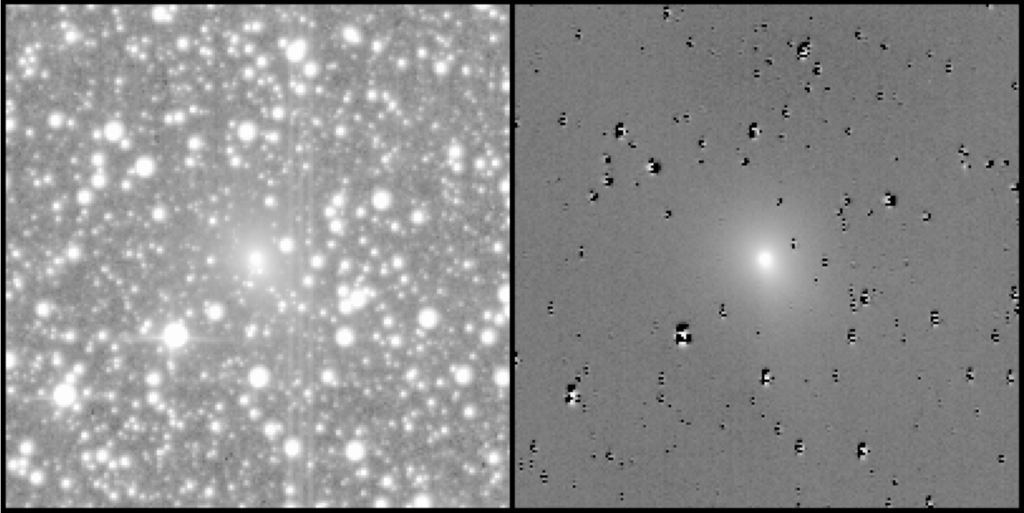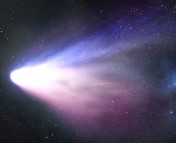Title: First Results from TESS Observations of Comet 46P/Wirtanen
Authors: Tony L. Farnham, Michael S. P. Kelley, Matthew M. Knight, and Lori M. Feaga
First Author’s Institution: Department of Astronomy, University of Maryland
Status: Submitted to ApJ Letters, closed access (pre-print available on arxiv)
The Transiting Exoplanet Survey Satellite (TESS) has been searching for exoplanets since the summer of 2018 (and will continue to till at least 2022). Its initial two year mission consists of scanning almost the entire sky. Like its predecessor Kepler, TESS searches for planets by staring at a part of the sky for an extended period of time, in the hope of catching a transit. However, while Kepler stared at one part of the sky for years, TESS moves from sector to sector on roughly a monthly basis (see Figure 1).

TESS’s observing style makes it suitable for studying objects other than planets, such as comets. Comets change rapidly, meaning that TESS’s month-long monitoring of each sector is perfect for studying them.
Comet 46P/Wirtanen zipped across TESS’s field of view while it was observing Sector 3 last year (late September to mid October). To make things even more special, Wirtanen experienced an outburst that TESS caught from start to finish — the first time a cometary outburst has been so thoroughly observed.
In the paper discussed in this Astrobite, the authors use TESS data to characterize Wirtanen and its outburst, as well as how it compares to other comets.
Disappearing Stars and Dusty Trails

To capture Wirtanen’s behavior alone, the authors had to first subtract off all the background stars that could contribute to Wirtanen’s brightness (see Figure 2). They did this by using Difference Image Analysis software that was written for use on TESS data (see this Astrobite for more). The software identifies and removes all constant sources in a set of images, allowing for the variable sources — like comets — to be easily identified and studied.
Once Wirtanen had been isolated, the authors were able to obtain its light curve — how Wirtanen’s brightness changed as TESS was observing it (see Figure 3). The aforementioned outburst caused Wirtanen to brighten steadily as it passed through TESS’s view. The authors attribute this to the comet’s reflectivity being increased by ejected dust. The TESS images also turned up a newfound dust trail associated with Wirtanen.

Dusting Off the History Books
To understand Wirtanen, the authors turned to previous instances of comet outbursts as well as Wirtanen’s own history. It was atypical for Wirtanen to experience an outburst, with only three other outbursts observed since its discovery in 1948. This rules out any mechanisms that would produce frequent outbursts, such as a volatile region on the comet that could become unstable as the comet travels through the solar system. For alternatives, other well-observed comet outbursts — of which there are few — could be helpful.
About half the outbursts of Comet 29P/Schwassmann-Wachmann 1 (SW1) are periodic but one observed in 2017 initially behaved in the same way as the Wirtanen outburst. The 2007 outburst of Comet Holmes caused a brightening of 15 magnitudes, much larger than Wirtanen’s. Holmes’ brightening also happened in phases, but instead of slowing with time the brightening sped up. This was likely due to large dust particles breaking into smaller ones, increasing the overall reflective area.
In 2005, Comet Tempel 1 experienced an outburst induced by the Impactor on the Deep Impact probe (not that one). This outburst happened in three phases, initially behaving like Wirtanen and SW1 but brightening sharply with time like Holmes.
These similar but distinct events suggest that the velocity and character of any ejected material plays a large role in the appearance of outbursts. Using Wirtanen’s change in brightness and assuming the type of material ejected, the authors estimate that Wirtanen kicked off a hundred thousand to ten million kilograms of material. An ejection like this would leave behind a crater, similar to those left behind on Tempel 1.
Catching more of these events will help us understand comets much better. Fortunately, in its initial two year mission alone, TESS ought to catch about 50 comets. Wirtanen is a good case study of how cometary science can be done with TESS and hopefully marks the beginning of a new offshoot of TESS science.





Thoroughly enjoyed reading this story.